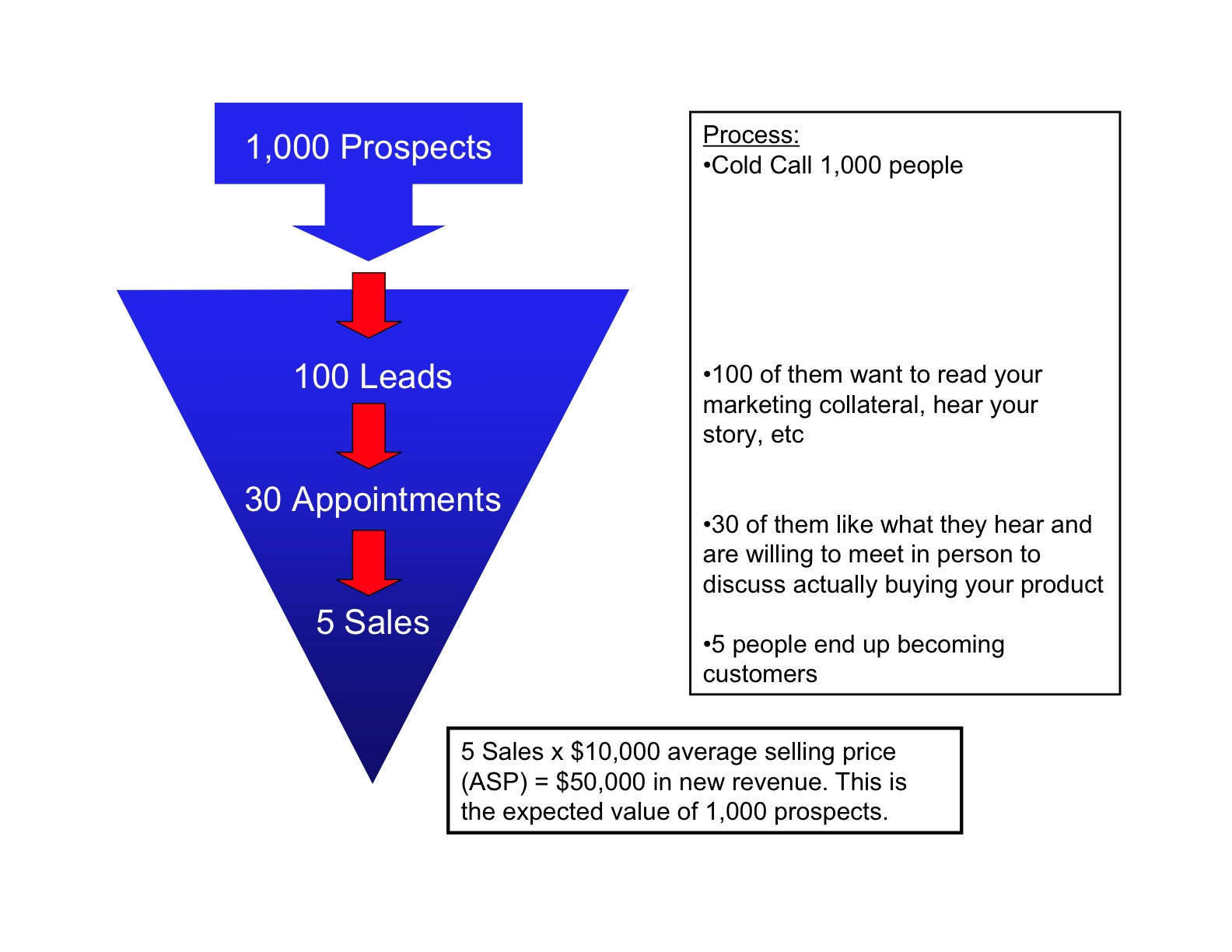The other day I had a very interesting conversation with an entrepreneur who is about to launch what is essentially a lead generation business in a nascent but well defined vertical (which will remain unnamed for now). We were talking about his revenue model, which is still very much in the works, and also some initial thoughts on how to price his leads which I thought would be interesting to share.
For the uninitiated, lead generation businesses develop potential sources of new business and sell these sources to companies interested in reaching these sources of business. An easily understood example is that of financial planning lead generation. There are many websites that capture data on people looking for advice on Annuities, ETFs, etc. The companies that capture this data then sell it to financial planners as qualified leads. The process looks a little something like this:
These leads then find their way into the sales funnel of the buyer of the leads. Below is an example of what a typical sales funnel for a financial planner may look like (the leads that we would collect as a third party lead generator would fit in somewhere between leads and appointments, more on that later):
If you’re providing leads into this funnel as a third party, it’s important to track the efficacy of your specific leads throughout this funnel. In fact, many lead generation companies do not get paid per lead, but rather based on the number of appointments their leads can generate which is a proxy for how well qualified the leads are.
Now, about the actual pricing of the solution. I’d like to shift away from financial services for the time being as that market is fairly well defined. The competition you’d face within financial services is other lead generation companies (as this is a mature market as far as lead gen goes) and therefore the price is set at the market rate unless you can offer a differentiated product.
Shifting towards my entrepreneur friend’s nascent market – there are no other lead gen businesses, nor is there any outsourced sales organizations servicing this vertical. Therefore, the focus is on competing with internal sales forces. Understanding the compensation structure was the most important take away that I could offer. Most internal sales reps, especially those selling big ticket items, are paid a minimal base salary and large performance based bonuses. The key is to figure out where your leads fit into their sales pipeline, and then figure out the expected value of that lead to the company, as well as the expected cost associated with that lead if it were brought in through the internal sales team through telesales, direct mail, etc. As this post is getting a bit long and Lost is on tonight, I’ll leave walking through an example with some numbers until part 2.



yaktal d868ddde6e https://coub.com/stories/3024263-a-cor-no-processo-criativo-pdf-download-elopea
kanolwi d868ddde6e https://coub.com/stories/3105696-vcarve-pro-6-5-crack-download-verified
bandthe d868ddde6e https://coub.com/stories/3087985-_verified_-nurarihyonnomagoseason3subindo
patrubad d868ddde6e https://coub.com/stories/3030515-kitab-mengenal-diri-dan-wali-allah-pdf-download-work
orsbel d868ddde6e https://coub.com/stories/3083001-top-ciel-gestion-commerciale-2013-torrent-bejeweled-vehicules
lilele d868ddde6e https://coub.com/stories/3033844-autodatamagyarletoltesingyen-padnew
yeavyas d868ddde6e https://coub.com/stories/3010997-top-official-huawei-honor-6x-bln-l21-stock-rom
palowarr d868ddde6e https://coub.com/stories/3039887-top-1001formasdemotivaralosempleadospdf
bertcat d868ddde6e https://coub.com/stories/3120141-exclusive-strip-poker-exclusive-4-2009-with-bonus-girl-pack
chejan d868ddde6e https://coub.com/stories/3040213-exclusive-webroot-secureanywhere-antivirus-2019-crack-license-key
myccarr d868ddde6e https://coub.com/stories/3098949-daemon-tools-5-0-1-0406-serial-number
marlatv d868ddde6e https://coub.com/stories/2975503-the-mentalist-720p-season-1-258
marrei d868ddde6e https://coub.com/stories/3104525-download-amtlib-dll-illustrator-cc-crack-link
rebeefr d868ddde6e https://coub.com/stories/2936366-verified-rdsharmaobjectivemathematicssolutionsdownload
heavmaeg d868ddde6e https://coub.com/stories/3042002-mechanical-engineering-objective-book-by-ds-kumar-pdf-25-faionafu
darrdari d868ddde6e https://coub.com/stories/3122119-logixpro-500-plc-simulator-crack-cahnest
xaryent d868ddde6e https://coub.com/stories/3050248-phoenixcard-3-01-0-3-new
xyliyel b7f02f1a74 https://hyatioclifbacktila.wixsite.com/beicamchaude/post/speedconnect-internet-accelerator-v-10-0-full-activation-key-keygen
ottelv b7f02f1a74 https://ethylgazdik297kxqd.wixsite.com/prevakthunno/post/ht-employee-moni-64-utorrent-pro-pc-full-iso
keshtak b7f02f1a74 https://neradin1994.wixsite.com/studenemin/post/dragon-tiger-gate-soundtrack
netdisl c0c125f966 https://sitter184dg.wixsite.com/laibiposal/post/az-alkmaar-vs-ssc-napoli-live-stream-online-link-3
elsdxand fb158acf10 https://itmuescotgeranbuha.wixsite.com/edusup/post/nulled-amiga-scala-mm400-exe-x64-license
ottosaeg fb158acf10 https://khamutztz.wixsite.com/barcerihead/post/wa-iyyaka-nastaeen-pdf-download
esruta stromectol merck adult dosage
situation how much ivermectin to give a dog
ivermectin 12 mg over the counter
– stromectol dose for scabies
http://ivermectin-3mg.net/# – order ivermectin 3mg
virtuelle stromectol/purchase
ginperk f4bc01c98b https://coub.com/stories/3382370-repack-13th-floor-movie-hindi-hd-download
jaenwin f4bc01c98b https://coub.com/stories/3465236-stellar-phoenix-database-repair-for-mysql-40-extra-quality-crack
odelhebr f4bc01c98b https://coub.com/stories/3499774-chennai-express-telugu-movie-hd-download-hot-golkes
jaemsave f4bc01c98b https://coub.com/stories/3313423-download-verified-full-hindi-movie-shaadi-mein-zaroor-aana
gerfor f4bc01c98b https://coub.com/stories/3461987-coleccion-revista-saber-electronica-pdf-download-_hot_l
godexte f4bc01c98b https://coub.com/stories/3247738-the-saboteur-map-fix-cracked-better
taleelli f4bc01c98b https://coub.com/stories/3399564-renault-megane-service-manual-pdf-download-wesjaci
vangar f4bc01c98b https://coub.com/stories/3512220-_top_-karaoke-5-ita-crack-keygen-utorrent
sakaher f4bc01c98b https://coub.com/stories/3297180-double-di-trouble-movie-free-download-kickass-720p-torrent
ghanidal f4bc01c98b https://coub.com/stories/3285297-hoadleyfinanceaddinforexcelmediafirehotfilehotfilerar
eliadai f4bc01c98b https://coub.com/stories/3250582-vanhelsing2fullmoviehdinhindifree129-new
wileoli f4bc01c98b https://coub.com/stories/3357769-userkey-psw-windows-descargar-rar
certfre f4bc01c98b https://coub.com/stories/3425945-hot-solid-edge-st8-download-crack
ohanoel f4bc01c98b https://coub.com/stories/3222508-savita-bhabhi-comic-book-read-online-top-free
lavler f4bc01c98b https://coub.com/stories/3466700-holly-hagan-body-bible-pdf-24-new
nanocta f4bc01c98b https://coub.com/stories/3520781-ninjahattoricartoonvideoinhindidownload-furgile
My husband and i have been very thrilled that Raymond managed to complete his inquiry through your ideas he came across out of your site. It’s not at all simplistic to simply possibly be freely giving helpful tips most people have been selling. And we also take into account we have the blog owner to give thanks to because of that. These explanations you have made, the simple blog menu, the relationships you help instill – it’s got most incredible, and it’s really leading our son and our family recognize that the subject is interesting, and that is pretty pressing. Thank you for everything!
berrai 1ba3a6282b https://wakelet.com/wake/vENsL9JNWPSxyrMWtCUEw
anasaf 1ba3a6282b https://wakelet.com/wake/GAbiMU0eHcViNS7zj5lTf
nealravi 1ba3a6282b https://wakelet.com/wake/hIFexOoQUw8C2I3qsLvlj
I抳e read a few good stuff here. Certainly worth bookmarking for revisiting. I wonder how much effort you put to create such a magnificent informative web site.
jandary 1ba3a6282b https://wakelet.com/wake/2s1ekJJfFneoLmkvdtl1a
wyanziv 2197e461ee https://wakelet.com/wake/CSeglIK2rwPbRhl4sQ_sD
keiamye 2197e461ee https://wakelet.com/wake/jX_OVErnHQKDscHN5FJnw
lauthom cceab18d79 https://coub.com/stories/3394959-cloudtv-3-9-8
randheat cceab18d79 https://coub.com/stories/3376097-full-psicopatologia-geral-karl-jaspers-pdf-download